Balancing personalization trends and customer data privacy is no easy task in 2025. However, when your brand manages to do so, you are more likely to build a strong customer base while using AI, high-quality data, and emerging technologies.
Our experts at Business2Community carefully analyzed a large swathe of research reports and surveys to find the top personalization trends for 2025, giving you everything you need to stay ahead of the game.
Key Personalization Trends
- Email marketing, mobile apps, and websites were the top three channels marketers personalized.
- 92% of businesses used AI-powered personalization to drive growth.
- A personalized experience would make a customer loyal to a brand, according to 65% of survey respondents.
- 80% of consumers expect personalization and a better customer experience, considering all the data companies collect.
- Almost half of Gen Z consumers would be less likely to shop from a brand once they’ve had an impersonal experience.
- 78% of businesses agree that first-party data is the most valuable source for personalization.
What are 2025’s Personalization Trends?
For 77% of business leaders, personalization improves customer retention, according to a 2023 Zendesk CX report.
Customers agree – in the same report, 62% said that they preferred personalized recommendations to general ones, and 60% said they were able to tell when companies deliver personalized interactions and when they don’t.
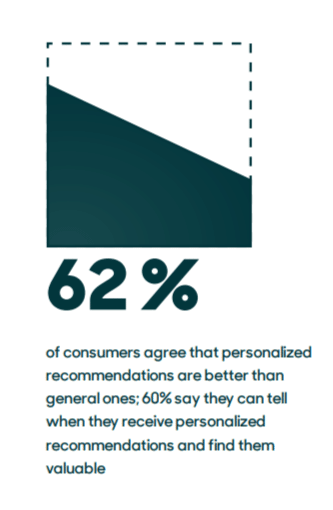
1. Email is the Top Channel Companies Personalize
Since 2020, email marketing has remained the most popular channel for marketers to personalize.
Besides using customers’ names in the introduction, companies also implement more complex personalization strategies in emails. For example, they customize the subject line, personalize the email content, and collect data to make sure the content is relevant to customers’ online behavior and interests.
According to Salesforce, mobile apps and websites were the two other top personalization channels as of December 2022.
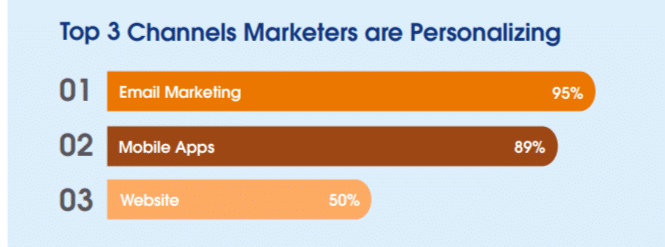
Darren Noble, VP of Enterprise Sales at Hootsuite says that some sellers think inserting customers’ names in the email subject line is enough for personalization. In 2025, this is no longer the case, given that 73% of customers expect companies to understand their unique needs, notes Salesforce.
To go beyond inserting names, companies use audience segmentation based on location, gender, previous purchases, or behavior.
North American vacation rental company Vacasa launched a personalized email and SMS campaign to engage customers and increase bookings. By using Segment’s customer data platform, Vacasa segmented users’ behavior and reservation data, which was then used by the marketing team to send personalized holiday recommendations.
As a result, the company experienced a 3x increase in guest bookings from email campaigns.
Below is an example email Vacasa sent to a user who viewed the property called Summer Sliving. The company could see that the user checked out the property but had not booked.
Assuming that the user was interested in renting a vacation home nearby, Vacasa sent an email with booking links to Summer Sliving and four other similar properties.

2. Businesses Agree That AI Makes Customer Experience More Personal
Segment’s State of Personalization Report found that 92% of businesses used AI-powered personalization to drive growth.
Another survey by Boston Consulting Group in 2023 focused on generative AI and found that 67% of companies have used generative AI for personalization. Examples of use cases include:
- Writing product descriptions
- Offering 24/7 customer support with AI chatbots
- Analyzing data to offer personalized rewards
49% of marketers in a 2023 Hubspot report agreed that AI was useful for creating more personalized content. It helps localize and edit content based on customers’ location, create specific customer segments, use predictive analysis to forecast customer behavior, and more.
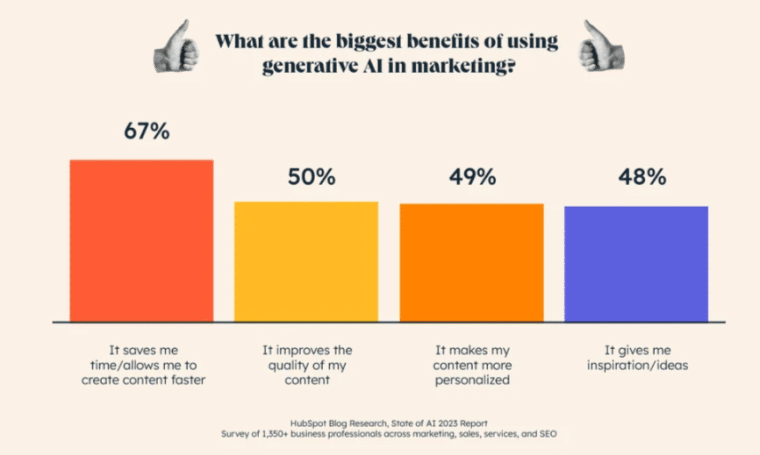
Many subcategories of artificial intelligence help personalize customer experiences. For example, the facial recognition market is expected to grow at a CAGR of 16.4% from 2023 to 2032 notes Allied Market Research. From retail to security, brands use facial recognition technology in creative ways.
The cosmetics company Sephora, for example, has had facial recognition features in its app for years. With this technology, users can try on Sephora products virtually and make an informed decision when they are ready to purchase.
3. Human-Centric Personalized Experiences Are Trending
In an interview with For the Record, Emily Galloway, Spotify’s Head of Product Design for Personalization, highlighted the importance of using AI in a human way while developing personalization strategies.
Spotify’s 2023 personalization initiative was the AI DJ, which uses generative AI and personalization technologies to come up with specific music recommendations. “DJ is the perfect example of how we’re driving deeper, more meaningful connections through technology,” said Emily Galloway, when talking about how the AI DJ uses technology while keeping the human element.
Human-centric personalization strategies encourage customers to spend more time using the brand’s products or services.
For instance, Netflix uses AI and machine learning algorithms to analyze user behavior, viewing history, and preferences. This way, it is able to suggest movies or shows users might like.
The more users spend time watching shows, the more accurate the algorithm gets. It’s a win-win situation – users discover more relevant shows and have a good time, and Netflix benefits from increased engagement and retention.
4. Personalization is Driving Brand Loyalty
Salesforce surveyed 5,000 consumers in 2022 to learn what they thought about personalization, the speed of customer service, and data privacy.
76% of customers said they would stay loyal to companies that provide better data security, 72% said they would shop again from brands that deliver fast service, and 65% said a personalized experience would make them loyal.
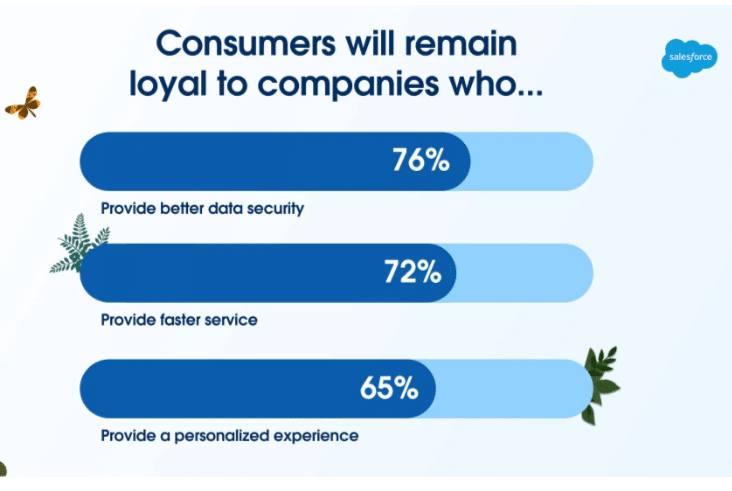
Moreover, 81% of consumers said they were willing to reassess their budget, as they would like to prioritize personalization in their customer journey.
For companies looking to launch brand loyalty programs, investing in personalization is key. Antavo’s Global Customer Loyalty Report 2023 found that the average annual spend of members who redeemed personalized offers was 4.5x higher than those who had never done so.
Brand loyalty programs see a high ROI thanks to personalization. One of Antovo’s survey questions was about the strategy brands would most like to invest in for brand loyalty. Personalization was the top answer, outranking infrastructure, rewards, program revamp, and reporting and mobile experience.
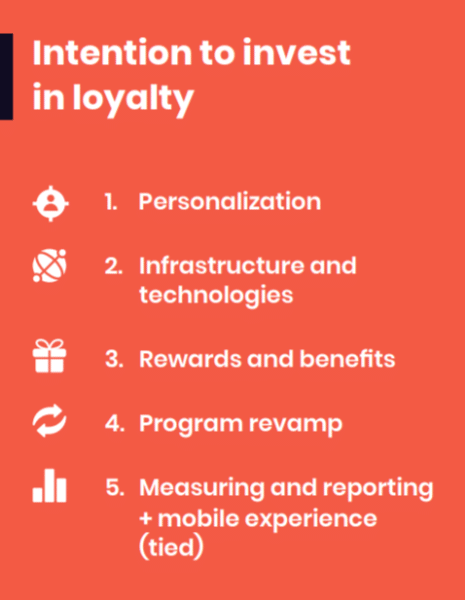
5. Prioritizing Customer Data Privacy is More Important Than Ever
As personalized experiences slowly become the norm and AI makes its way into companies, customers are experiencing data privacy concerns. They may not like overly personalized marketing efforts that seem to have used an uncomfortable amount of personal information.
According to Segment’s State of Personalization Report that we looked at earlier, only 51% of customers trust brands with their personal data. The same report found that 23% of customers were less comfortable with companies using their data for personalization.
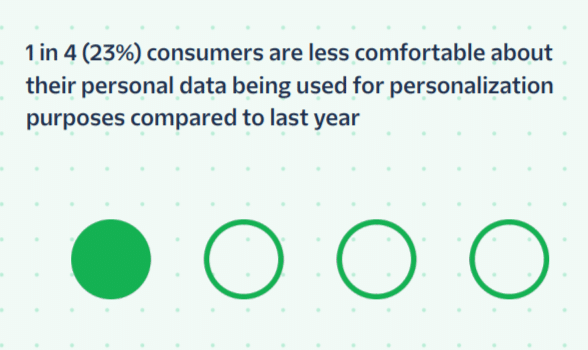
Although this raises concerns about how to personalize content, the link between personalization and customer data is not all black and white. Companies can increase customer trust by prioritizing transparency and keeping customers informed about their data collection practices.
For example, 44% of customers are comfortable with brands collecting first-party data, while only 30% are comfortable with third-party data.
Similarly, Salesforce notes that 71% of customers report that they would trust a company more if they knew how their data would be used, and 80% expect a better customer experience in return for the data they provide.
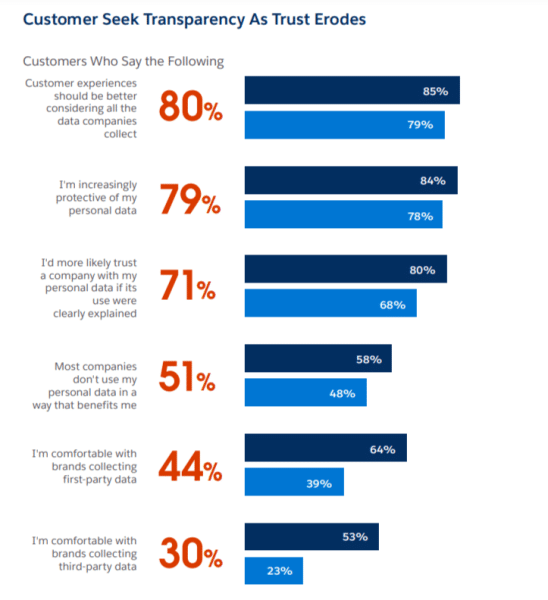
These survey results suggest that companies need to rely more on zero-party data and first-party data instead of third-party cookies, especially when Google is planning to limit third-party cookies in 2024.
According to Ana Villegas, CMO at NI, the challenge of balancing personalization and customer data presents an opportunity for brands to stand out. Once they strike the right balance, brands will be able to foster stronger relationships, build trust, and earn customer loyalty.
6. Customer Expectations for Personalization Have Increased
In 2025, customers have high expectations for personalized content throughout the customer journey, despite all the concerns related to personal data collection.
Young customers in particular expect to see different types of personalization. For example, in an Idomoo survey, 72% of Gen Z and Millennials said they would be interested in receiving personalized videos.
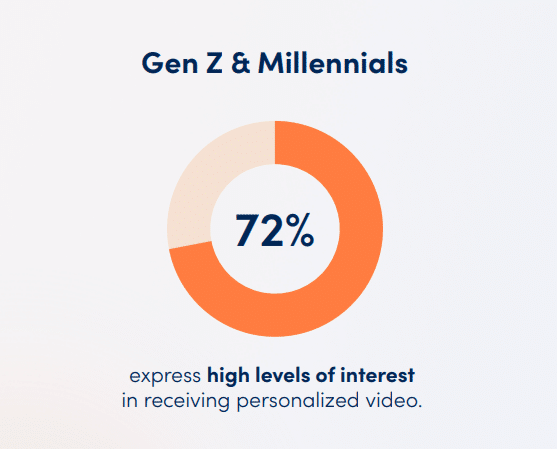
Impersonal content or ads are a reason for Gen Z to quit buying from the company.
Almost half of Gen Z consumers say that they would be less likely to shop from a brand after an impersonal customer experience, notes Segment. Another 27% say they would stop shopping altogether.
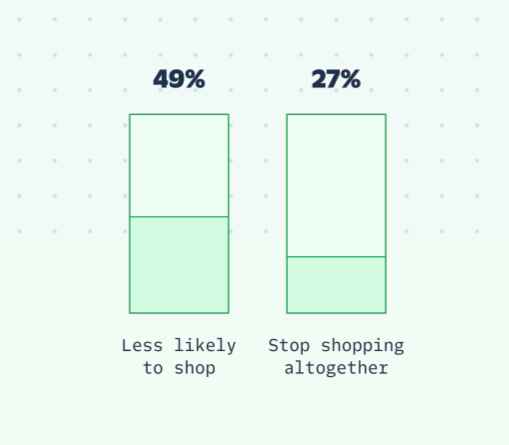
In addition to this, The State of the Connected Customer 2023 Report found that over 60% of customers expect personalization in the following situations:
- when technology advances (73%)
- when they provide more data (74%)
- when they spend more money (64%)
7. The Use of Personalization by Brands Cuts Across Industries
Many businesses have more than one service and offerings. For example, ecommerce brands such as Amazon and Shopify are also marketplaces and service providers. This creates a platform economy, increasing the need for personalization.
An IBM report in 2023 looked at how personalization affected sales and conversion rates. For a grocery chain, the IBM experience design team identified 100 personalization opportunities and chose to implement automatic replenishment, targeted recommendations, and personalized landing pages.
The grocery company experienced a 176% increase in online revenue, a 25% increase in conversion rates, and a 10% average increase in order size.
Other industries also use personalization to generate leads and make more sales. For example, banks and financial institutions recommend personalized investment plans based on customers’ risk appetite.
Restaurants target audiences using location-based marketing, with the aim of attracting customers at peak meal times.
Travel agencies run personalized marketing campaigns to recommend destinations users are interested in, and so on.
8. Personalization Tools Gather Customer Data in One Place
In 2025, companies use customer data platforms to streamline their personalization strategy. These tools make it possible to bring together data from multiple channels, including:
- Click-throughs, heat maps, browsing histories, and data from other company channels
- Data from a CRM
- First-party data that customers provide to companies themselves
- Third-party data collected from external sources
- Master and transactional data
- Insights and business intelligence data
Small business design and marketing company Vista needed a similar data solution to offer personalized experiences to its customers. By using Segment’s customer data platform, it collected data from different sources, including Google Analytics, Facebook Conversions API, and Quantum Metric.
This allowed Vista to run more experiments and achieve deeper personalization. The company also saw a 121% increase in click-through rate from the homepage dashboard and a 23% increase in onsite satisfaction in NPS promoters.
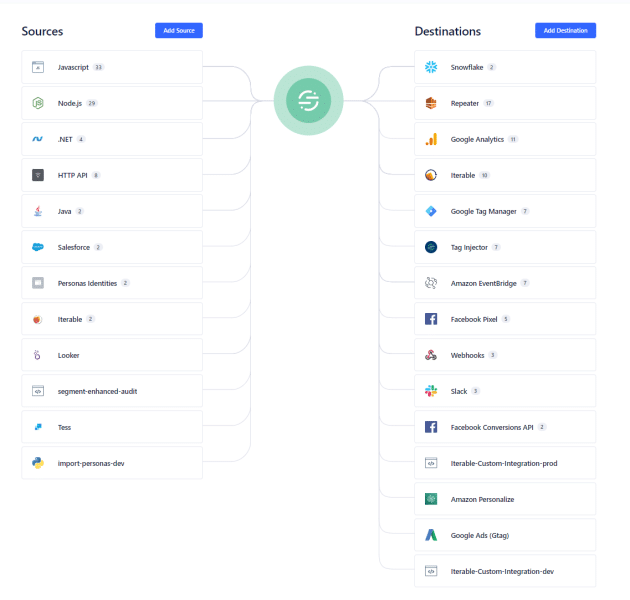
How to Find Personalization Trends
As third-party cookies become history and AI advances, personalization efforts and customer preferences will be affected. Here is how you can stay up-to-date with the industry and find the major trends to build your customer base.
Research Reports
Segment publishes the yearly State of Personalization Report, covering trends in personalization, consumer loyalty, and data privacy. Reports in different industries, including marketing and customer service, also mention personalization trends.
In addition to the Segment report, we used reports from Salesforce, Zendesk, Antavo, IBM, and HubSpot in this article.
Podcasts
The Good Data, Better Marketing podcast talks about data-driven marketing and personalization. Other marketing and customer experience podcasts also cover personalization, as it’s a trending topic.
Conferences
Personalization Pioneers Conference brings together people from different industries to talk about personalization trends, tactics, and use cases.
The Future of Personalization
With Google planning to end third-party cookies, first-party data will be even more important for the future of personalization.
In the State of Personalization 2023 Report, 78% of businesses said they considered first-party data to be the most valuable source to provide personalized experiences.
In 2022, Salesforce surveyed 4,000 commerce leaders and analyzed data from 1 billion buyers. It found that 36% of commerce organizations planned on investing in first-party data over the next two years.
According to the report, digital leaders in the commerce space understand the value of data, and they were 4x more likely to use data for personalized buying experiences compared to companies with less advanced digital processes, also known as digital laggards.
48% of employees working for digital leader organizations agreed that their organization was prepared to use data for personalization, whereas only 7% of employees at digital laggard organizations agreed.
These findings suggest that companies need to be more data-literate to keep up with the changes in the personalization scene.
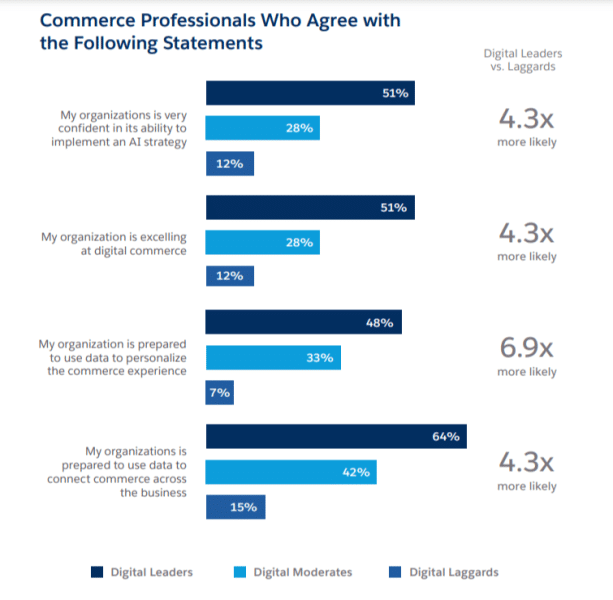
Both the Segment and Salesforce reports highlight the high ROI personalized marketing brings.
According to Segment, 56% of consumers said they would become repeat buyers after a personalized experience in 2023, representing a 7% YoY increase compared to 2022. Given these results, an effective personalization strategy is likely to bring a higher ROI in the upcoming years.
